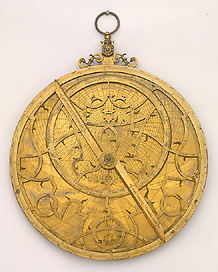
 |
| Catalogue |
 |
 Astrolabe The rete bears the names of 42 stars or groups of stars. The back of the instrument is a shadow square in the lower semicircle, and in the upper left quadrant is a diagram for conversions between equal and planetary hours based on the times of sunrise and sunset. The right quadrant is blank. Around the edge are divided scales for degrees, the zodiac, and the calendar. The alidade has one of its arms divided with a scale 0-10 labelled 'Horae ortus solis'. On either side of each sight is a wing, one with a hole and the other with a dot. The rule is divided on both arms 0? to 70?N and 0? to 20?S. The scales are labelled 'Declinatio septent:' and 'Declinatio merid:'. Associated with the astrolabe are six latitude plates (one made in Florence) and a seventh plate engraved with projections of the Earth from the North and South Poles. The plates are engraved for latitudes every 3? between 36? and 60?, and one has a tablet of horizons. The sixth plate is made for the latitude of Florence, 43?, and it is not from the same workshop as the rest of the astrolabe. It is attributed to Giovan Battista Giusti by G. L'E. Turner. The map plate is not provide with a lug nor with a hole for hanging. Made of copper, the land mass and decorative elements are gilded, while the seas are left as copper. One side is a North polar projection to the Tropic of Capricorn, while the other side is a South polar projection cut off at the Tropic of Capricorn. See G. L'E. Turner and E. Dekker, "An astrolabe attributed to Gerard Mercator, c.1570", Annals of Science, 50 (1993), pp. 403-43; and M. Miniati, Museo di Storia della scienza: Catalago (Florence, 1991), p.57. Mara Miniati |



